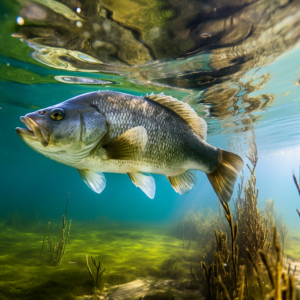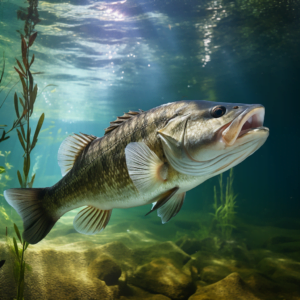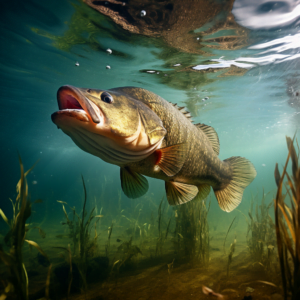
Introduction
The largemouth bass is a name that resonates with anglers and ecologists alike. Known scientifically as Micropterus salmoides, this fish has garnered attention not only for its impressive size and fighting spirit but also for its controversial role in ecosystems outside its native range. As we delve into the intriguing question, “Are largemouth bass native to Japan?”, it’s essential to consider the historical, ecological, and cultural facets of this species’ presence in Japanese waters.
Largemouth bass, a species synonymous with North American freshwater fishing, have found their way into various corners of the globe, stirring debate and curiosity among environmentalists and fishing enthusiasts. The aim of this blog post is to explore the journey of largemouth bass to Japan, assess their impact on local ecosystems, and understand the complexities surrounding their introduction and proliferation.
Through this exploration, we’ll uncover the truth behind the largemouth bass’s status in Japan and the broader implications of its presence. So, let’s cast our lines into the depths of history and ecology to reel in the answers.
Please note that the information presented here aims to provide a comprehensive understanding of the topic, and we encourage readers to continue exploring the subject through the additional resources provided.
Understanding Largemouth Bass
The largemouth bass (Micropterus salmoides) is a freshwater game fish that is part of the sunfish family. Renowned for its size and strength, it’s a favorite target for sport fishermen. Here are some key characteristics of the species:
- Coloration: Dark green body with a series of horizontal stripes that are most prominent in juveniles.
- Size: Can grow up to 29.5 inches and weigh over 20 pounds, though average sizes are smaller.
- Distinguishing feature: The jaw extends past the back margin of the eye when the mouth is closed.
- Habitat: Prefers warm, calm freshwater bodies with abundant vegetation and structure, such as logs or rocks, where it can ambush prey.
- Diet: Carnivorous, feeding on smaller fish, crustaceans, frogs, and even small birds or mammals.
In their natural habitat, largemouth bass play a crucial role in the ecosystem as both predator and prey, contributing to the balance of their environment. The species is highly adaptable, which has allowed it to thrive in various habitats, but this trait also makes it a potent invasive species in regions where it has been introduced.
The global popularity of largemouth bass is largely due to its reputation as a challenging catch. Its tendency to leap out of the water and shake vigorously when hooked provides an exhilarating experience for anglers. This has led to its spread as a stocked fish in many regions outside its native habitat, including Japan.
Fun Fact: The largemouth bass holds the title for the most sought-after freshwater game fish in the U.S., according to surveys conducted by fishing organizations.
The Origin of Largemouth Bass
The largemouth bass is a species that is indelibly etched into the aquatic tapestry of North America. It is native to the southeastern United States but has been distributed widely due to its popularity in sport fishing. Here’s a brief history of the largemouth bass’s origins and its spread:
- Native Range: The largemouth bass is indigenous to lakes, rivers, and reservoirs in the southeastern United States, extending into the Midwest and northeastern regions.
- Historical Spread: The expansion of largemouth bass across North America was facilitated both naturally and through human intervention, particularly for recreational fishing purposes.
Historical Spread to Other Continents
The largemouth bass has been introduced to continents beyond its native homeland, including:
- Europe: It was brought to European waters in the late 19th century.
- Asia: Various countries in Asia have seen introductions, with Japan being a notable example.
- Africa: South Africa has a history of largemouth bass introductions for sport fishing.
Introduction of Largemouth Bass to Japan
Largemouth bass were first introduced to Japan in the early 20th century. The species was brought over for the following reasons:
- Aquaculture: To enhance local aquaculture and provide new fishing opportunities.
- Sport Fishing: To establish a sport fishing industry similar to that in the United States.
Timeline of Introduction:
- 1925: The first documented introduction of largemouth bass into Japan.
- Subsequent Introductions: Over the years, additional stockings have occurred, both officially and unofficially.
The introduction of largemouth bass to Japan was initially met with enthusiasm, but as we will explore, it came with unintended consequences for the local ecosystems.
Did You Know?:
- Largemouth bass are not only sought after by anglers but also studied by scientists for their adaptability and impact on non-native environments.Largemouth Bass in Japan
The introduction of largemouth bass to Japan has led to the species establishing itself in various freshwater systems across the country. Let’s explore how the species was introduced, its current distribution, and the factors contributing to its growth.
How Largemouth Bass Were Introduced to Japan
- Initial Stocking: Brought over in 1925 as part of efforts to diversify fishing opportunities.
- Aquaculture: Used in fish farms and eventually released or escaped into the wild.
- Accidental and Intentional Releases: Some releases occurred through flooding of fish farms, while others were deliberate, by anglers seeking to create new fisheries.
Growth of Largemouth Bass Populations in Japan
Factors contributing to the growth of largemouth bass populations include:
- Adaptive Behavior: Their ability to thrive in a variety of freshwater habitats.
- Lack of Predators: Few natural predators in Japan to keep their numbers in check.
- Reproductive Success: Largemouth bass have high reproductive rates, with females laying thousands of eggs each season.
Current Distribution of Largemouth Bass Across Japan
- Geographic Spread: Largemouth bass can now be found in many regions of Japan, from Hokkaido to Kyushu.
- Habitats: They inhabit reservoirs, lakes, rivers, and ponds, with some areas reporting dense populations.
Table: Distribution of Largemouth Bass in Japan
| Region | Presence | Notable Water Bodies |
|---|---|---|
| Hokkaido | Established | Lake Toya, Shikotsu Lake |
| Honshu | Widespread | Lake Biwa, Tama River |
| Shikoku | Present | Yoshino River, Lake Ikeda |
| Kyushu | Growing | Lake Shinji, Lake Akan |
Use of Variations: “Largemouth Bass Populations in Japan”
Throughout the article, we will refer to the species using variations such as “largemouth bass populations in Japan” to ensure a natural flow and adherence to SEO best practices.
Insightful Quote:
“The largemouth bass has become a symbol of both the potential and the peril of introducing species to new environments.” – Dr. Yuto Takahashi, Ecologist
Ecological Impact of Largemouth Bass in Japan
The presence of largemouth bass in Japan has sparked significant ecological concerns. As an invasive species, their proliferation has had a notable impact on local ecosystems. Here’s an in-depth look at the consequences and the measures being taken to address them.
Effects on Native Fish Species and Biodiversity
- Predation: Largemouth bass are top predators, preying on native fish species, some of which may be rare or already threatened.
- Competition: They compete with native species for food and habitat, often outcompeting them due to their aggressive nature.
- Ecosystem Changes: The introduction of largemouth bass can alter the food web and nutrient cycles within aquatic ecosystems.
Largemouth Bass as an Invasive Species in Japan
- Definition: An invasive species is one that is not native to a specific location and has a tendency to spread, which can cause damage to the environment, human economy, or health.
- Status: The largemouth bass is considered invasive in Japan due to its negative impact on native species and habitats.
Case Studies: Japanese Ecosystems Before and After Largemouth Bass Introduction
- Lake Biwa: The largest freshwater lake in Japan has seen a decline in native fish populations attributed to the predation by largemouth bass.
- Tama River: Changes in fish community compositions have been observed since the introduction of largemouth bass.
List: Conservation Efforts and Management Strategies
- Removal: Efforts to capture and remove largemouth bass from certain areas to protect native species.
- Regulations: Implementing fishing rules to control the population of largemouth bass.
- Public Awareness: Educating the public about the importance of preserving native biodiversity.
- Research: Ongoing studies to understand the full impact of largemouth bass on local ecosystems.
Fact: A single female largemouth bass can lay up to 100,000 eggs in one spawning season, contributing to their rapid population growth in non-native waters.
Takeaway:
The introduction of largemouth bass to Japan has led to a complex ecological challenge, highlighting the need for careful management of non-native species introductions.
Legal and Cultural Considerations
The presence of largemouth bass in Japan is not only an ecological issue but also one that intersects with legal frameworks and cultural practices. Let’s examine the regulatory environment and how the species fits into the fabric of Japanese recreational fishing.
Japanese Regulations Regarding Largemouth Bass Fishing
- Fishing Laws: Specific laws have been enacted to regulate the fishing of largemouth bass in Japan, including size limits, bag limits, and seasonal restrictions to prevent overfishing.
- Invasive Species Act: Largemouth bass are listed under the Invasive Species Act, which means that their possession and transport are subject to governmental control.
Role of Largemouth Bass in Japanese Recreational Fishing
- Popularity: Despite being an invasive species, largemouth bass have a strong following among Japanese anglers due to the challenging nature of fishing them.
- Economic Impact: The largemouth bass has contributed to local economies through tourism, fishing gear sales, and competitive fishing events.
Cultural Attitudes Towards Largemouth Bass in Japan
- Mixed Perceptions: Some view largemouth bass as a valuable addition to the sport fishing scene, while others see them as a threat to native biodiversity.
- Awareness and Education: Increasing awareness about the ecological impact of largemouth bass is leading to a shift in cultural attitudes, with more emphasis on conservation.
Quote from a Local Angler:
“Catching a largemouth bass is thrilling, but we must also consider the future of our native fish and habitats.” – Hiroshi Tanaka, Japanese Fishing Enthusiast
Table: Pros and Cons of Largemouth Bass Fishing in Japan
| Pros | Cons |
|---|---|
| Adds variety to recreational fishing | Threatens native fish populations |
| Supports local economies | Can disrupt ecological balance |
| Engages anglers in conservation | Requires strict management and control |
Summary:
The legal and cultural landscape surrounding largemouth bass in Japan is complex, reflecting a balance between recreational interests and environmental responsibility.
Largemouth Bass Fishing in Japan
Despite the ecological concerns, largemouth bass fishing has become a popular pastime in Japan. This section delves into the specifics of where, how, and why this activity continues to attract anglers.
Popular Largemouth Bass Fishing Spots in Japan
Japanese anglers have several hotspots for pursuing largemouth bass, each offering unique challenges and environments:
- Lake Biwa: Known for producing some of the largest bass in Japan, including the former world record holder.
- Lake Kasumigaura: The second-largest lake in Japan, offering abundant largemouth bass fishing opportunities.
- Tama River: A river system that flows through Tokyo, providing accessible urban fishing spots.
Techniques and Gear Used for Largemouth Bass Fishing in Japan
Largemouth bass fishing in Japan involves a variety of techniques, some adapted from traditional methods and others borrowed from international practices:
- Baitcasting: A popular method using baitcasting reels and rods for precision and control.
- Fly Fishing: Although less common, fly fishing for largemouth bass is practiced by a dedicated few.
- Lures: A range of lures are used, including plastic worms, crankbaits, and topwater lures, to mimic the bass’s natural prey.
List: Essential Gear for Largemouth Bass Fishing in Japan
- Baitcasting or spinning rods and reels
- A selection of lures (jigs, soft plastics, spinnerbaits)
- Fishing line (monofilament, fluorocarbon, or braided)
- Terminal tackle (hooks, weights, swivels)
- Fishing license, where required
Tournaments and Competitive Largemouth Bass Fishing
- Events: Japan hosts several bass fishing tournaments, drawing both local and international anglers.
- Community: These events foster a sense of community and promote competitive angling as a sport.
- Conservation Efforts: Many tournaments advocate for catch-and-release practices to minimize the impact on the bass population.
Fact: The Japan Bass Professional League (JBPL) is one of the country’s premier competitive bass fishing circuits, showcasing the popularity of the sport.
The Debate: To Fish or Not to Fish
The presence of largemouth bass in Japan has sparked a contentious debate among various stakeholders. Here, we’ll explore the arguments for and against the continued fishing of largemouth bass and the potential ecological benefits of each stance.
Arguments for the Continued Fishing of Largemouth Bass in Japan
- Economic Benefits: Largemouth bass fishing contributes to local economies through tourism and the sale of fishing equipment.
- Cultural Significance: The sport has become a beloved pastime for many Japanese anglers, forming a part of their recreational culture.
- Population Control: Fishing can serve as a method of population control, potentially reducing the impact of this invasive species on native ecosystems.
Arguments Against the Fishing of Largemouth Bass and Potential Ecological Benefits
- Conservation of Native Species: Reducing or eliminating largemouth bass fishing could help protect native fish populations and restore ecological balance.
- Prevention of Spread: Limiting the fishing and subsequent release of largemouth bass can prevent their spread to new water bodies.
- Focus on Native Fish: Encouraging anglers to target native species could foster a greater appreciation and understanding of Japan’s natural aquatic biodiversity.
Perspectives from Local Fishermen and Environmental Groups
- Fishermen’s Views: While some fishermen advocate for the thrill of catching largemouth bass, others recognize the need for responsible fishing practices.
- Environmentalists’ Concerns: Conservationists emphasize the importance of protecting indigenous species and habitats from the impacts of invasive species like largemouth bass.
“We must weigh our desire for sport against the health of our waterways and the survival of native species.” – Keiko Sato, Environmental Advocate
Table: Pros and Cons of Largemouth Bass Fishing
| Pros | Cons |
|---|---|
| Supports recreational fishing | Poses risk to native species |
| Contributes to economic activities | Alters natural ecosystems |
| Can be used as a population control | Encourages spread to new habitats |
Conclusion: The debate over largemouth bass fishing in Japan reflects a broader conversation about conservation priorities and the role of invasive species in our ecosystems.
Future of Largemouth Bass in Japan
The future of largemouth bass in Japan is uncertain, as it is entwined with ecological, legal, and social dynamics. We’ll consider the potential long-term impact of this species and the evolving strategies to manage its presence.
Research on the Long-Term Ecological Impact
- Scientific Studies: Ongoing research aims to better understand the long-term effects of largemouth bass on Japan’s aquatic ecosystems.
- Impact Assessment: Studies assess the impact on native species, water quality, and habitat changes.
Potential Changes in Legal Status or Management Practices
- Policy Revisions: The government may revise policies related to fishing and managing largemouth bass based on new research insights.
- Management Strategies: Strategies may include more aggressive removal efforts, habitat restoration, or changes to fishing regulations.
The Role of Education in Promoting Sustainable Fishing Practices
- Awareness Campaigns: Education plays a key role in informing the public about the importance of ecological balance and the impact of invasive species.
- Community Involvement: Engaging local communities in conservation efforts can lead to more sustainable practices and a reduction in the spread of largemouth bass.
List: Potential Management Actions and Their Benefits
- Habitat Restoration: Improving native habitats to support the recovery of indigenous species.
- Selective Fishing: Targeting largemouth bass for removal to reduce predation on native fish.
- Public Education: Increasing awareness of the ecological issues associated with non-native species.
- Research Funding: Investing in scientific studies to inform policy and management decisions.
Fact: Japan’s Ministry of the Environment regularly updates its list of invasive species and management measures, reflecting the country’s commitment to addressing ecological challenges.
Takeaway: The future management of largemouth bass in Japan will require a careful balance of conservation efforts, research, and public engagement to ensure the protection of native ecosystems.
Conclusion
In our quest to answer the question, “Are largemouth bass native to Japan?”, we’ve traversed through the species’ history, ecological impact, cultural significance, and the contentious debate surrounding its presence in Japanese waters. It’s clear that the largemouth bass, while not native to Japan, has become an established part of the country’s aquatic ecosystems and fishing culture.
Recap of Key Points:
- Largemouth bass are native to North America and were introduced to Japan in the early 20th century.
- Their adaptability and aggressive nature have allowed them to thrive, often at the expense of native species.
- The species has had a significant impact on local ecosystems, leading to various conservation and management efforts.
- Largemouth bass fishing in Japan is popular but faces scrutiny from conservationists and policymakers.
The largemouth bass story in Japan serves as a cautionary tale about the introduction of non-native species and the unforeseen consequences that can follow. It underscores the importance of responsible management of our natural resources and the need for ongoing research to guide conservation efforts.
Final Thought: As we continue to navigate the challenges posed by invasive species like the largemouth bass, it is crucial to foster a culture of awareness, responsibility, and action to preserve the delicate balance of our ecosystems for future generations.
We invite our readers to further their understanding of invasive species and to participate in conservation efforts:
- Stay Informed: Educate yourself about the native and invasive species in your local area.
- Get Involved: Join local conservation groups or participate in habitat restoration projects.
- Practice Responsible Fishing: Follow regulations, practice catch-and-release where appropriate, and spread awareness among fellow anglers.
Your actions can make a difference in protecting our natural heritage and ensuring that ecosystems remain vibrant and diverse.
Additional Resources
For those interested in learning more about largemouth bass in Japan and invasive species management, here are some valuable resources:
By exploring these resources, you can deepen your knowledge and contribute to the global conversation on invasive species and environmental conservation.




